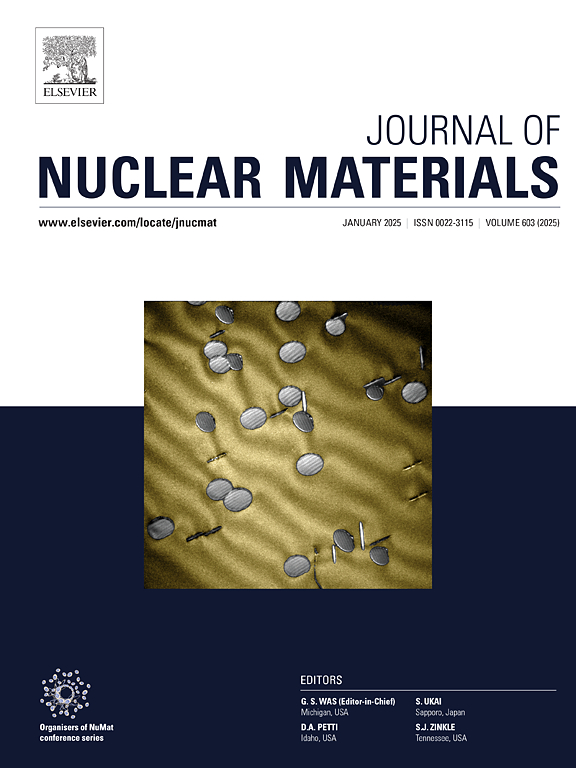Investigation of the IGR research reactor’s uranium-graphite fuel's high-temperature corrosion by a combination of thermal analysis and mass-spectrometry methods
IF 2.8
2区 工程技术
Q3 MATERIALS SCIENCE, MULTIDISCIPLINARY
引用次数: 0
Abstract
The National Nuclear Center of the Republic of Kazakhstan (NNC RK) operates two unique research reactors – IVG.1 M and IGR, both of which are undergoing a conversion program to reduce nuclear fuel enrichment from 90 % to 19.75 % by 235U In 2023, the conversion of the IVG.1 M reactor was successfully completed. NNC RK is currently conducting various studies related to the conversion to a new uranium-graphite fuel for the IGR reactor. One such study focuses on the corrosion processes of the fuel surface under normal operating conditions and in various emergency situations, associated with the penetration of oxygen and water vapor into the reactor core. The study of changes in the basic physical and chemical properties of uranium-graphite fuel during interaction with chemically active gases and vapor-gas mixtures is crucial for predicting material behavior under various operating conditions.
This paper presents the results of the study of high-temperature corrosion of unirradiated uranium-graphite fuel of the IGR research reactor, using a combination of thermal analysis and mass spectrometry methods. During the experiments, data were obtained on the sample temperature, sample mass, heat flux to the sample, and changes in the composition of the reaction gas (vapor-gas mixture) in the chamber, which was purged throughout the experiment. The results of the high-temperature corrosion experiments of experimental, highly enriched uranium-graphite fuel in the reaction chamber of a thermogravimetric analyzer, with different compositions of chemically active gases, are presented. An analysis of the experimental data enabled the identification of corrosion mechanisms and the determination of the parameters of these processes.
采用热分析和质谱相结合的方法研究了IGR研究堆的铀-石墨燃料的高温腐蚀
哈萨克斯坦共和国国家核中心(NNC RK)运行着两个独特的研究堆——ivg . 1m和IGR,这两个反应堆都在进行转换计划,以减少核燃料浓缩从90%到19.75%的235U。2023年,ivg . 1m反应堆的转换成功完成。NNC RK公司目前正在进行各种与转换为IGR反应堆的新型铀-石墨燃料有关的研究。其中一项研究的重点是在正常操作条件下和各种紧急情况下燃料表面的腐蚀过程,这与氧气和水蒸气渗透到反应堆堆芯有关。研究铀-石墨燃料在与化学活性气体和蒸汽-气体混合物相互作用过程中基本物理和化学性质的变化对于预测材料在各种操作条件下的行为至关重要。本文介绍了采用热分析和质谱相结合的方法对IGR研究堆未辐照铀-石墨燃料高温腐蚀的研究结果。在实验过程中,获得了样品温度、样品质量、对样品的热流密度以及在整个实验过程中被净化的反应气体(蒸汽-气体混合物)的组成变化的数据。本文介绍了不同化学活性气体组成的高浓铀-石墨燃料在热重分析仪反应室内的高温腐蚀实验结果。对实验数据的分析使腐蚀机理的识别和这些过程的参数的确定成为可能。
本文章由计算机程序翻译,如有差异,请以英文原文为准。
求助全文
约1分钟内获得全文
求助全文
来源期刊

Journal of Nuclear Materials
工程技术-材料科学:综合
CiteScore
5.70
自引率
25.80%
发文量
601
审稿时长
63 days
期刊介绍:
The Journal of Nuclear Materials publishes high quality papers in materials research for nuclear applications, primarily fission reactors, fusion reactors, and similar environments including radiation areas of charged particle accelerators. Both original research and critical review papers covering experimental, theoretical, and computational aspects of either fundamental or applied nature are welcome.
The breadth of the field is such that a wide range of processes and properties in the field of materials science and engineering is of interest to the readership, spanning atom-scale processes, microstructures, thermodynamics, mechanical properties, physical properties, and corrosion, for example.
Topics covered by JNM
Fission reactor materials, including fuels, cladding, core structures, pressure vessels, coolant interactions with materials, moderator and control components, fission product behavior.
Materials aspects of the entire fuel cycle.
Materials aspects of the actinides and their compounds.
Performance of nuclear waste materials; materials aspects of the immobilization of wastes.
Fusion reactor materials, including first walls, blankets, insulators and magnets.
Neutron and charged particle radiation effects in materials, including defects, transmutations, microstructures, phase changes and macroscopic properties.
Interaction of plasmas, ion beams, electron beams and electromagnetic radiation with materials relevant to nuclear systems.
 求助内容:
求助内容: 应助结果提醒方式:
应助结果提醒方式:


